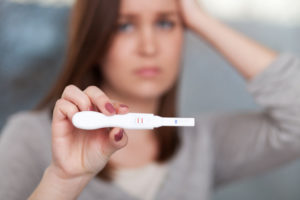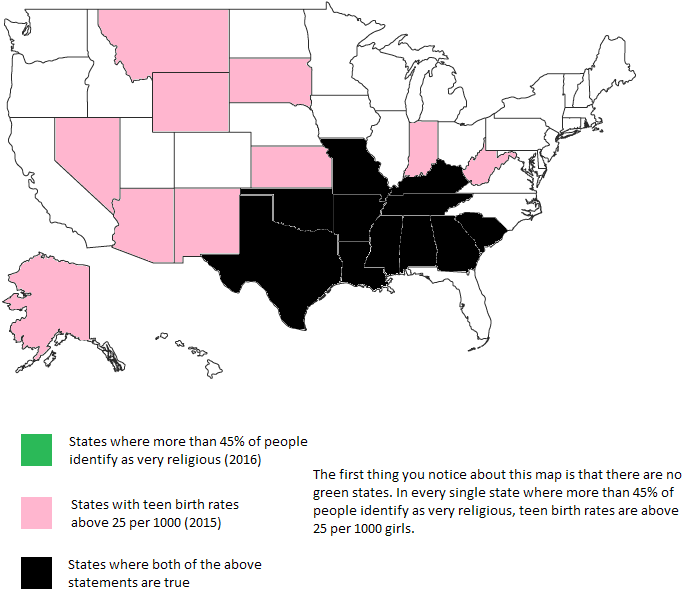Linking Religion and Teen Pregnancy: There’s a Map for That

Everyone’s heard the old saw: “Don’t close the stable door after the horse has bolted.” Sadly, it provides an excellent introduction to the shocking state of sex education in US public schools, and the wide degree to which its quality varies based on where one’s school is.
For example, the lawmakers of Tennessee have decided that sex education in their state should be mandatory only if the pregnancy rate among fifteen- to seventeen-year-olds is above 19.5 per 1,000 girls. In other words, these policymakers are willing to surrender their “family values” only if a certain threshold is reached, and even then just until the rate can be brought under control again. Aside from being a classic example of closing the stable door after the horse has bolted, this also raises some very interesting questions. For one thing, it suggests that lawmakers know that sex education is effective at addressing teen pregnancy rates—that’s why they’re willing to deploy it if the necessity arises. Why, then, would they wish to implement it only selectively? The answer lies in the Judeo-Christian morality that dominates this country. Further examination of the ways in which sex education and religiosity vary across the United States reveals a link between the two and the impact this has on what’s taught in the classroom.
Here’s a fact: in no state where at least 45 percent of people identify as very religious is the teen birth rate below twenty-five births per 1,000 girls. We’re talking about Alabama, Arkansas, Georgia, Kentucky, Louisiana, Mississippi, Missouri, Oklahoma, South Carolina, Tennessee, and Texas—otherwise known as the Bible Belt. Correlation is not causation, and there are certainly many factors that contribute to teen birth rates, but it seems clear that deep religiosity does not provide an outstanding starting point for states hoping to address unplanned teen pregnancies.
In Alabama, Arkansas, Louisiana, Missouri, Oklahoma, and Texas, schools are not required to provide sex education. Mississippi made sex education mandatory in 2011, but also required that it be abstinence-based and forbade contraceptive demonstrations. As mentioned, in Tennessee sex-ed is mandatory only if teen pregnancy rates reach a certain level; even then, it has to be abstinence-based, and teachers can be sued by parents for promoting what is termed “gateway sexual activity.” Even in South Carolina, Kentucky, and Georgia, the three states on this list with the least-objectionable on-paper sex education laws, it’s still required that abstinence be the focus. And in South Carolina any mention of non-heterosexual sex outside the context of STDs is forbidden.
To compare, let’s look at the sex education laws and religiosity of the five states where teen birth rates are the lowest—Connecticut (10.1); Massachusetts (9.4); New Hampshire (10.9); New Jersey (12.1); and Vermont (11.6). Of these states, only New Jersey, at 34 percent, has more than 30 percent of residents identifying as “very religious.”
Connecticut, Massachusetts, and New Hampshire don’t mandate that public schools provide sex education, although New Hampshire does require students to be educated about STDs. Vermont requires sex education and encourages schools to emphasize the importance of condoms and to create a program for condom distribution. Vermont also has the lowest percentage of residents identifying as “very religious” (21 percent). New Jersey also requires schools to provide sex education, including instruction in different methods of contraception.
It seems like there are two important relationships here: 1) states that are more religious are less likely to have robust (or any) sex-education curricula, and 2) it seems likely that, outside of the school setting, community values influence the sexual behavior of teenagers. That is, in states like Connecticut and Massachusetts, low teen birth rates may be partially the result of a less regressive climate surrounding sex and contraception than one finds in, say, Alabama or Louisiana. A 2015 Center for Disease Control study of ninth and twelfth graders found that the two states with the greatest percentage of students who had been on birth control at the time of their last sexual intercourse were Vermont (34.6) and New Hampshire (32.7). Not far behind were Massachusetts (28.4) and Connecticut (26.8). When compared to Bible Belt states, where the percentage of students using birth control ranged from 22.9 to 14.9 percent, it’s clear the effect restrictive social environments can have on the sexual decision-making of teens.
Certain states ought to be prioritized in the fight to make quality sex education and contraception available to all. That being said, all states could certainly benefit from a more humanistic approach to these issues, one focused on meeting the needs of individuals without giving credence to archaic belief systems that harm the very people they claim to protect. From both a moral and evidence-based perspective, there is a need for rational, humane intervention in this country’s hijacked sexual health laws.

